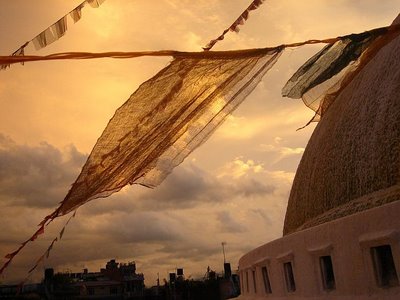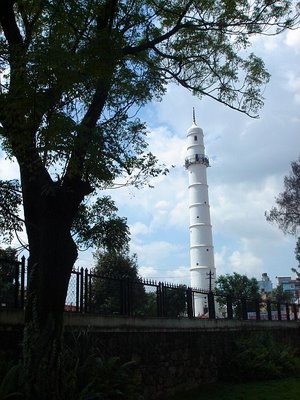Kathmandu, Nepal
The Kathmandu Valley has been
 called the world's largest open-air museum. Priceless historic carvings, statues and monuments are strewn casually, even carelessly, around. Old men sit chatting on the plinths of Hindu carvings and drunks lie in the shadow of Buddhist stupas. Little kids clamber all over the mythical chimeric animals (part lion, part eagle, part dragon) that guard the countless viharas, temples and courtyards. Probably some art historian would think it's destructive. I think it's cool that so much of the stuff is still a part of the city's everyday life. And it makes doing a chore, like going to the post office or the bank, an exotic adventure back into time.
called the world's largest open-air museum. Priceless historic carvings, statues and monuments are strewn casually, even carelessly, around. Old men sit chatting on the plinths of Hindu carvings and drunks lie in the shadow of Buddhist stupas. Little kids clamber all over the mythical chimeric animals (part lion, part eagle, part dragon) that guard the countless viharas, temples and courtyards. Probably some art historian would think it's destructive. I think it's cool that so much of the stuff is still a part of the city's everyday life. And it makes doing a chore, like going to the post office or the bank, an exotic adventure back into time.That is, if you walk through the right parts of town. It's possible to walk to the General Post Office completely in the 21st century, or the 18th. If you head
 down Tridevi to Kantipath then over to New Road, you can walk through four-lane traffic past concrete buildings (though none rise higher than five or so stories - thank God). Or, you can walk through Thamel to Jyatha, Vijaya Punani, Tyora, Asan Tol and Indra Chowk to Sundhara, down herringbone brick lanes practically tripping over goats, mud puddles and ancient statuary. You will get lost down the myriad alleyways, but that's part of the fun. I don't think I have ever walked the same way twice.
down Tridevi to Kantipath then over to New Road, you can walk through four-lane traffic past concrete buildings (though none rise higher than five or so stories - thank God). Or, you can walk through Thamel to Jyatha, Vijaya Punani, Tyora, Asan Tol and Indra Chowk to Sundhara, down herringbone brick lanes practically tripping over goats, mud puddles and ancient statuary. You will get lost down the myriad alleyways, but that's part of the fun. I don't think I have ever walked the same way twice.I had to go mail some books to my friend Tim in England- something I had promised to do a couple weeks ago. I had managed to find not one, but two Lonely Planet Travel Atlases for India & Bangladesh. This is a priceless travel resource, and of course, it is now out of print. Since Kathmandu has some of the best bookstores on the subcontinent, my friend at Alpine Books got ahold of a couple for me to send to Tim, at an only slightly inflated price. I guess that's to be expected, considering that the book is scarce these days.
Between the rain and various weird deadlines and festivals, it never seemed the right day to go. Finally a sunny day with no pressing agenda, no political strikes, no rituals enacting ancient legends and no stomachaches dawned. A rarity in Nepal!
A few of my favourite things
Here are a few things I saw on my way to the GPO.
--Butterfly kites and wooden kite-string reels on sale in Jyatha.
 Changa Chait, the big kite-flying festival, has its final round this Sunday in Nagarkot. I think Floriane and I will take the bus up on Saturday. It's a great excuse to see green trees and breathe clean air (I guess you do need an excuse to do that these days).
Changa Chait, the big kite-flying festival, has its final round this Sunday in Nagarkot. I think Floriane and I will take the bus up on Saturday. It's a great excuse to see green trees and breathe clean air (I guess you do need an excuse to do that these days).Everywhere I looked, on the street and on rooftops, little kids (always boys for some reason) were fixated on their kite reels. Usually they had an older brother up in the building or on the rooftop helping them detangle. At the Boudhanath Stupa, kites mingled with crows, circling hawks and prayer flags in the autumn sky.
Mahaboudha -- There are countless stupas, or three-dimensional pagodas whose structural
 symbolism represents "the mind of the Buddha," throughout Kathmandu city. The style with the wise Buddha eyes is unique to Nepal. Tibetans are the most well-known Buddhist community, but in fact about 15% of Nepalis are Buddhists, mainly Newari Buddhists, and these stupas were built by their ancestors.
symbolism represents "the mind of the Buddha," throughout Kathmandu city. The style with the wise Buddha eyes is unique to Nepal. Tibetans are the most well-known Buddhist community, but in fact about 15% of Nepalis are Buddhists, mainly Newari Buddhists, and these stupas were built by their ancestors. Mahaboudha is one of many neighborhoods centered around a stupa, the same way a typical southern American town would be centered around a clocktower. Mahaboudha is now a place for buying electronic goods and appliances. In addition to the usual foot traffic and livestock, there are also delivery vans clogging up the narrow alleyways dispatching boxes of microwaves and blenders.
Nepali Buddhist stupas look very different from their southeast Asian counterparts. The stupas in countries like Sri Lanka and Thailand are much more austere, with little or no figurative artwork.

In Nepal, the stupas are covered in a profusion of guardian creatures, faces, eyes, winged figures and a
 ll manner of animistic (ani mystic?) pagan-looking curlicues and doodads. Lots more fun than the others, which I find too sleek and very impersonal. Rather than serene, pure white, The Nepali stupas seem to be bursting with life.
ll manner of animistic (ani mystic?) pagan-looking curlicues and doodads. Lots more fun than the others, which I find too sleek and very impersonal. Rather than serene, pure white, The Nepali stupas seem to be bursting with life.At the base of Mahaboudha stupa, there were little kids playing, the usual sleepy street dogs and a few grubby drunks lying in the Buddha's shadow. Maybe they will get some enlightenment from passing out in a holy place.
--Things fall apart: I have to
 smile every time I pass this crumbling house. It is literally being propped up with long 2x4s (and it's not the only one of its kind). There are still people doing business in the ground floor, maybe even living in there. It looks like it will disintegrate any minute.
smile every time I pass this crumbling house. It is literally being propped up with long 2x4s (and it's not the only one of its kind). There are still people doing business in the ground floor, maybe even living in there. It looks like it will disintegrate any minute.Somehow, this doesn't stop life from going on. In the west, it would have been condemned and destroyed years ago, and it would have had all sorts of yellow tape and barriers to prevent anyone from going near it. Here, there are no liability lawsuits....so it's just your tough luck if it collapses while you're in there.
Dharahara Tower-- This pseudo-Mughal monument was built by some Rana general in the 1800s. A few weeks ago, some guy committed suicide by
 jumping off the top. During the Rana regime, the rulers began emulating foreign architectural styles (from both India and Europe) with some decidedly mixed results.
jumping off the top. During the Rana regime, the rulers began emulating foreign architectural styles (from both India and Europe) with some decidedly mixed results.The view from here is probably great in a few weeks, when the monsoon clouds finally burn off for good. But the fees they charge for this are bizarre. It's something like, practically nothing for Nepalis, a few rupees for citizens of SAARC countries (South Asian Association for Regional Cooperation), and about $5.00 US for everyone else. Forget it!
There is nothing exciting about this rather ugly tower other than a potentially decent view and a good workout for the calf muscles. I wonder if any foreigners ever bother going inside.
There is a legend that some crazy army general rode his horse all the way up the stairs, and off the top of the tower. Supposedly, the man survived because he used an umbrella. The horse was not so fortunate.
Its location does make it easier to find the post office.
Serpent Fountains--Until twenty or thirty years ago, public fountains were a viable, thriving place to get one's water,
 cool off and socialize. Nepal has a unique style of ornately carved, sunken public fountain/pool called "hiti." They are often dedicated to various gods (for instance, Narayanhiti was the fountain of Narayan, or Vishnu).
cool off and socialize. Nepal has a unique style of ornately carved, sunken public fountain/pool called "hiti." They are often dedicated to various gods (for instance, Narayanhiti was the fountain of Narayan, or Vishnu).In a few places, the hiti are still flowing and functioning. Mostly, however, they are green and scummy, if not completely dried up. A combination of lowered water tables, slackening monsoons and the proliferation of indoor plumbing and alternate water sources has left most in disrepair.
These sunken stone fountains are a marvel of art, architecture and urban planning. There are concentric scalloped steps, surmounted by statues of various deities and guardians, and each
 spigot is an ornate face or mouth - usually of a serpent or water creature.
spigot is an ornate face or mouth - usually of a serpent or water creature.The one by Dharahara is larger than most, and especially fantastic. It's called SundarHiti (beautiful fountain). Just imagine how lovely it must have been, with fresh water gushing from the mouths of the bronze dragon-heads.
To get some idea of the fountain's scale, you can see the passers-by sitting on the outside ledge. Easily 100 people could have fit in this pool. A few months ago I was able to descend the steps into the dried pool and touch the heads of the water-demons. Now, the entrance has been roped off. Perhaps they are in the process of restoring it - I sincerely hope so.
In Bhaktapur and some smaller towns, and even a few places in Kathmandu, you can still see women washing their hair, bathing (wearing a coverup sarong of course), drawing water in buckets, and washing clothes standing in these great stone fountains. Young kids play and splash all around them, and men hang out on the periphery, gossiping and smoking.

Forgotten Lions-- Just about anywhere, you can see statues guarding the entrances to small neighborhood temples, hidden away round every nook and cranny.
This leonine pair were guarding the locked-up entrance to a Shiva temple in Gaushala. They looked prepared to take on all comers, and it was kind of sad to see them staring for eternity into a grassy vacant lot. There are so many statues like this in Kathmandu, after a while, you almost don't see them.
I can envision a children's fantasy story, all about the stone creatures of Kathmandu and their secret lives. Perhaps on one special day, one of these magical midnights, during a particularly rare conjunction of planets every 12 years, they all come to life and roam silently through the darkened streets.














2 comments:
VIEWER MAIL
Linda in Illinois writes:
I just wanted to tell you that I thought your latest entry was awesome. loved it, loved the pics....
I don't belong here......
L.
So my friend, don't know what it is in your life has changed... but your photos surely show the difference! Great work and keep it up... I think that a DSLR is definately calling your name!!!
Really love the personalized posts and hope that you keep them up, much better than the blah blah blah typical articles that are plastered all over the WWW.
Missing you and that part of the world...
Rene`
Post a Comment